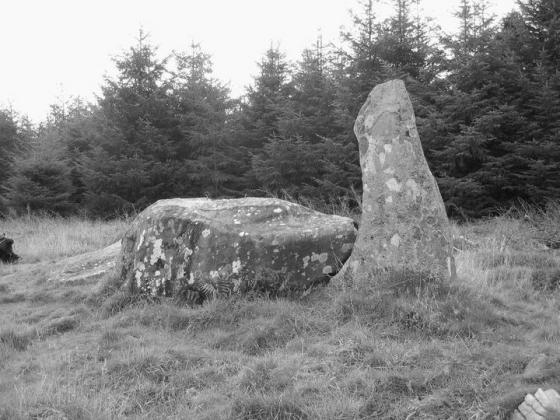
Berrybrae – complete with Drew-as-orthostat.

Berrybrae – complete with Drew-as-orthostat.


Despite being wet, cold and my wellies rubbing this was a place to linger and enjoy. Quiet, peaceful and alone

A short walk across a waterlogged ploughed field leads to this stone circle preserved within a small band of trees and fenced off from the surrounding farmland




Intact flanker.



09/02/2013 – Berrybrae Stone Circle

09/02/2013 – Berrybrae Stone Circle


Nature swallows this cute little stone circle...

The stone circle from the bank that surrounds the little wood. You can spot the kissing gate on the left side and the remaing stone on the right.

Excellent light at Aubrey’s site..


I was really taken by this flanker-its as big as most recumbents!


The shattered flanker – a clean break.

The boat-shaped recumbent sailing along the rubble bank.

The gargantuan flanker from outside the circle.

Beautiful piece of quartz chocking the huge flanker


Recumbent & Flankers (One broken)

Recumbent and west flanker from inside the circle.

Recumbent and west flanker from outside the circle.

A view across the best part of the circle showing the bank.

An example of the different colour of stone often found in RSCs.

Ocifant’s nightmare!!!! (The circle’s in the trees....)

Can you see it...? (I’ll get there one day....)
This stone circle, excavated by Aubrey Burl, is now heavily overgrown. There is still a surrounding fence and a kissing gate to enter the site inside the litte wood, but inside the fence there are no traces of someone, who looks after the site in terms of cutting the grass and saplings.
So I guess that in a few years, this site will be completely vanished and overgrown, which is a pity, because what I was able to trace was quite nice and the spot in the little wood adds to the atmosphere.
Visited June 2011
I was quite taken by Berrybrae. Although somewhat ruinous, I find these circles often have more ‘feel’ than their restored cousins-not that I’m averse to restoration.
The remaining flanker to this site is absolutely huge-almost as big as the recumbent. The other flanker has shattered, and the pieces are still in situ-it would still appear to have been smaller than the other flanker, although maybe as high. Two other circle stones are still standing, along with the stumps of at least two more. Some judicious chainsaw work is also required-it would open up the views no end, but also two very large trees are threatening the recumbent either by their roots, or from being blown down – and the wind does blow in this part of the world!
Access is as described, and easy as long as the field isn’t in crop or heaving with cows. Its less than 100 yards into the field so there’s no excuse for not visiting. Perhaps we can tread down the nettles together?
Foiled again, Moth! Moth has been trying to get here for years but has been consistently beaten back by cattle. Today, within sniffing distance there it was – this time we were held back by barley. There was no way we dared wade through that verdant crop against the tramlines. Very disappointed.
A fairly average RSC with a 3.3m long recumbent.
What makes the site interesting are the results of the Burl excavation which showed that, half a millennium or more after the circle was built, some stones were damaged and the ring cairn was destroyed in a redesign of the monument.
Access Parking at the nearby crossroads. Through the field gate and then the gate to the copse.
Visited 19 March 2005
A bit better known than the nearby Netherton, I believe this RSC has been excavated by the estimable Mr Burl.
On a raised platform and ringed by trees. From memory, I think it has been restored.
It’s well worth a visit, though I was unable to enter the field on my visits (seperated by only a couple of days). Bullocks. A lot of bullocks.
AND I had my dog with me! Nuff said.











































